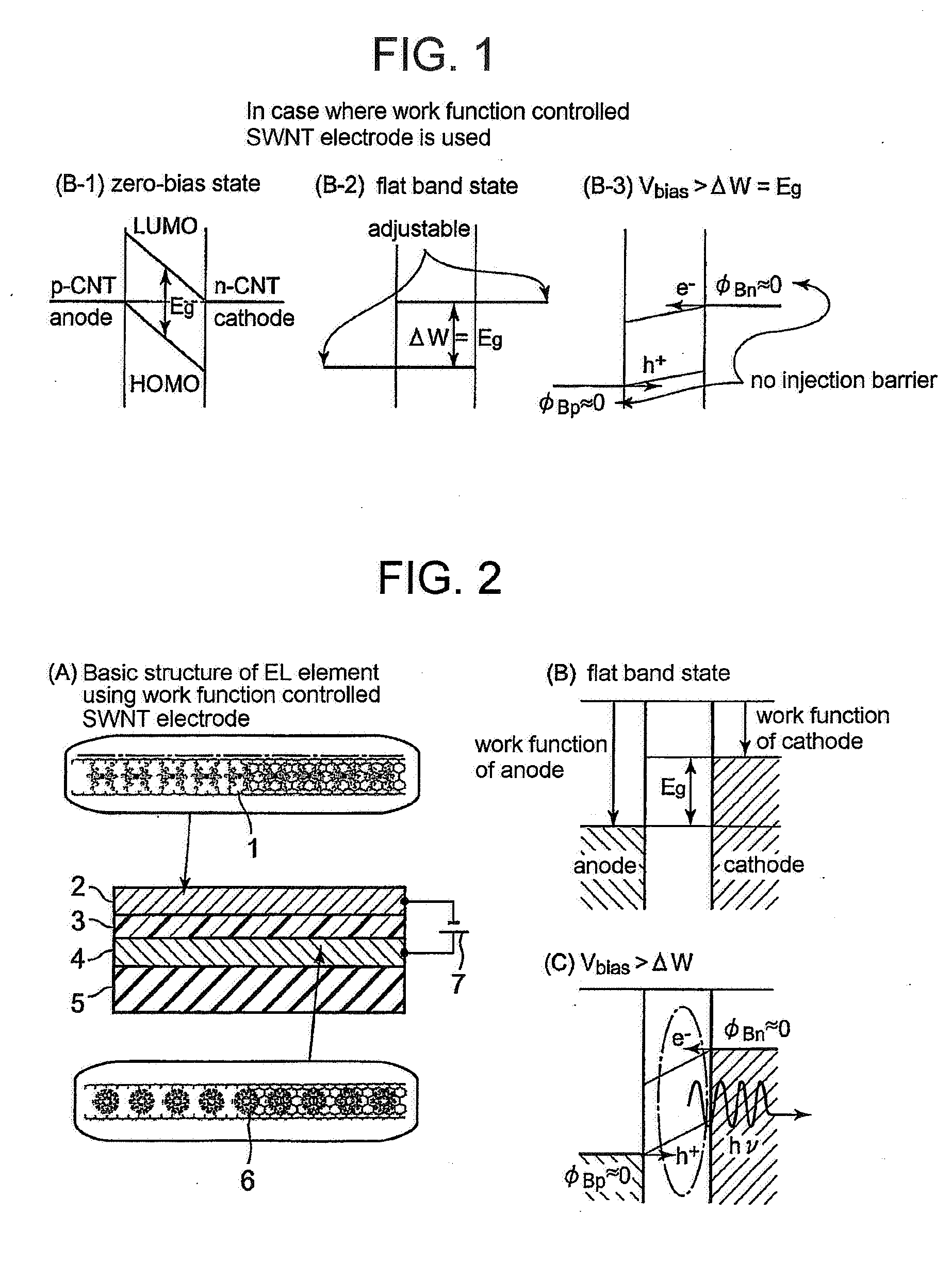Semiconductor device and method of manufacturing the same
a technology of semiconductors and semiconductors, applied in the field of semiconductor devices, can solve the problems of low conduction controllability, chemical instability of swnts channels, and inability to manufacture stably operable devices, etc., and achieve the effects of low power consumption of el elements, low cost, and simple structure of el elements
- Summary
- Abstract
- Description
- Claims
- Application Information
AI Technical Summary
Benefits of technology
Problems solved by technology
Method used
Image
Examples
examples
[0072]Next, examples of the present invention will be described. However, the present invention is not limited to these examples.
first example
[0073]Work function controllability of the SWNTs material shown in the present invention was examined both experimentally and theoretically. First, a SWNTs transistor having SWNTs as a channel was formed by a method described in Patent Document 4 (JP-A-2004-67413). Briefly describing the SWNTs transistor, gold / titanium was used for source and drain electrodes, a silicon oxide film of about 100 nm was used for an insulating layer, and highly-doped n-type silicon / gold was used for a gate electrode. The SWNTs channel was formed by in-situ growth by the catalytic chemical vapor deposition using hydrocarbon, such as methane, as a source material. The SWNTs channel has a diameter of typically 1 to 2 nm and a length of about 300 nm which is defined by a distance between the source electrode and the drain electrode. Next, the SWNTs channel was doped with a donor, such as cesium (IP=3.89 eV), potassium (IP=4.34 eV), or indium (IP=5.79 eV) by ion beam deposition and a drain current-gate volta...
second example
[0077]By the technique same as the first example, work function controllability of an acceptor doped SWNTs was examined. FIG. 7 shows an acceptor surface density dependence of work function shift of the acceptor doped SWNTs. (A) shows a case of fullerene monofluoride: C60F (EA=2.78 eV), (B) shows a case of iodine (EA=3.08 eV), and (C) shows a case of tantalum fluoride: TaF6 (EA=8.4 eV). Contrary to the donor doped SWNTs, as the acceptor surface density is increased, the work function shift is drastically extended in a plus direction so that the work function of the SWNTs is increased. When the acceptor surface density is around 1×1013 cm−2 in the cases of (A) and (B) and when the acceptor surface density is around 5×1013 cm−2 in the case of (C), the work function shifts tend to be saturated. At the acceptor surface density around 1×1015 cm−2, the work function shift is plus 0.6 eV in the cases of (A) and (B) and plus 0.68 eV in the case of (C) by actual measurement.
[0078]The accepto...
PUM
| Property | Measurement | Unit |
|---|---|---|
| ionization potential | aaaaa | aaaaa |
| temperature | aaaaa | aaaaa |
| temperature | aaaaa | aaaaa |
Abstract
Description
Claims
Application Information
 Login to View More
Login to View More - R&D
- Intellectual Property
- Life Sciences
- Materials
- Tech Scout
- Unparalleled Data Quality
- Higher Quality Content
- 60% Fewer Hallucinations
Browse by: Latest US Patents, China's latest patents, Technical Efficacy Thesaurus, Application Domain, Technology Topic, Popular Technical Reports.
© 2025 PatSnap. All rights reserved.Legal|Privacy policy|Modern Slavery Act Transparency Statement|Sitemap|About US| Contact US: help@patsnap.com



